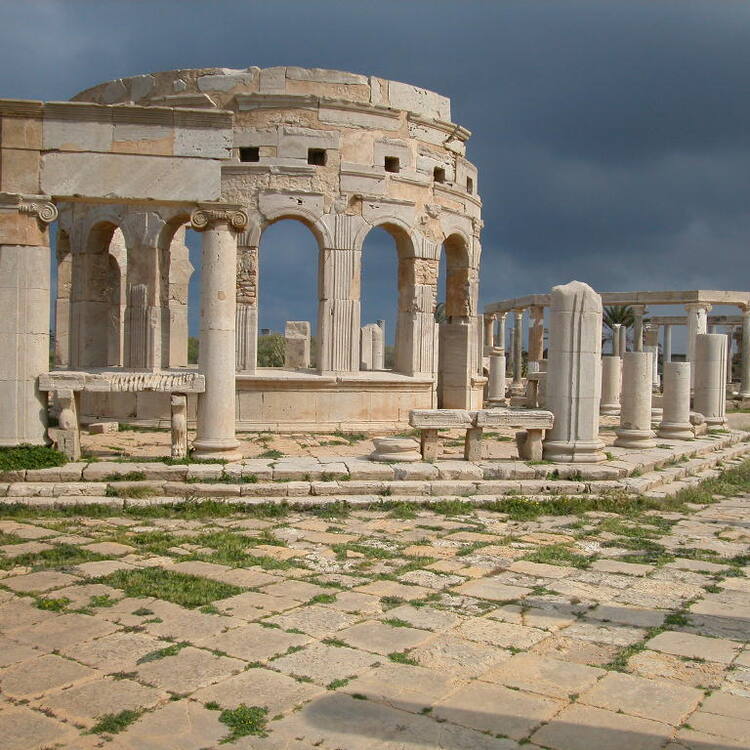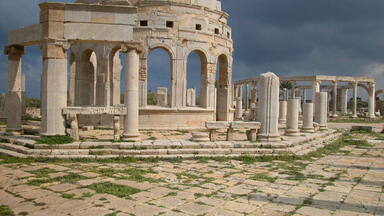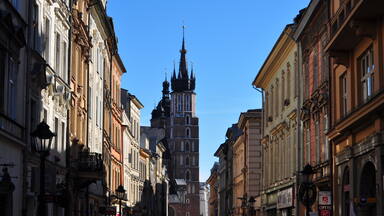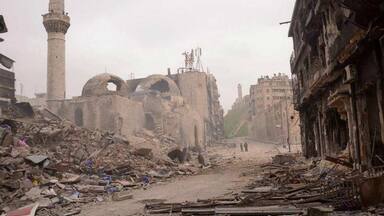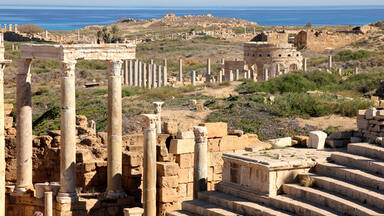Archaeological Site of Leptis Magna
Archaeological Site of Leptis Magna
Leptis Magna was enlarged and embellished by Septimius Severus, who was born there and later became emperor. It was one of the most beautiful cities of the Roman Empire, with its imposing public monuments, harbour, market-place, storehouses, shops and residential districts.
Description is available under license CC-BY-SA IGO 3.0
Site archéologique de Leptis Magna
Embellie et agrandie par Septime Sévère, enfant du pays devenu empereur, Leptis Magna était l'une des plus belles villes de l'Empire romain, avec ses grands monuments publics, son port artificiel, son marché, ses entrepôts, ses ateliers et ses quartiers d'habitation.
Description is available under license CC-BY-SA IGO 3.0
موقع لبدة الأثري (لبتس ماغنا) (لبدة الكبرى )
كانت لبدة إحدى أجمل حاضرات الامبراطورية الرومانية بعد أن جمّلها وكبّرها "سيبتيموس سيفيروس" ابن البلاد الذي أصبح امبراطورًا، وذلك بنصبها العامة الكبيرة، ومرفئها الاصطناعي، وسوقها، ومخازنها، ومحترفاتها وأحيائها السكنية.
source: UNESCO/CPE
Description is available under license CC-BY-SA IGO 3.0
莱波蒂斯考古遗址
莱波蒂斯是由塞普蒂斯乌斯·塞韦罗扩建并设计装饰的。他出生在那里并成为那里的国王。莱波蒂斯以其壮丽的公共纪念碑、人工港、市场、仓库、商店、居住区成为罗马帝国最美丽的城市之一。
source: UNESCO/CPE
Description is available under license CC-BY-SA IGO 3.0
Археологические памятники Лептис-Магны
Лептис-Магна была расширена и украшена Септимием Севером, который родился здесь, а позднее стал императором. Это был один из прекраснейших городов Римской империи, с внушительными общественными зданиями, гаванью, рыночной площадью, складами, магазинами и жилыми кварталами.
source: UNESCO/CPE
Description is available under license CC-BY-SA IGO 3.0
Sitio arqueológico de Leptis Magna
Embellecida y engrandecida por uno de sus hijos, el emperador romano Septimio Severo, la ciudad de Leptis Magna fue una de las más bellas del Imperio Romano, con sus grandes monumentos públicos, su puerto artificial, su mercado, sus almacenes, sus talleres y sus barrios de viviendas.
source: UNESCO/CPE
Description is available under license CC-BY-SA IGO 3.0
レプティス・マグナの古代遺跡
source: NFUAJ
Archeologische stad Leptis Magna
Source: unesco.nl
Outstanding Universal Value
Brief synthesis
The ancient city of Leptis Magna was founded as a temporary trading port by the Phoenicians in the 7th century BCE and expanded under the Roman Empire. It was significantly embellished by the Severan emperors in the 3rd century CE, transforming it into one of the most splendid cities of Roman North Africa. The surviving and excavated remains of the city reflect a unique artistic realisation in the domain of urban planning and in its application of monumental display. The city demonstrates a high level of engineering skill achieved in the creation of its infrastructure with the antique port of the city, situated at the mouth of Wadi Lebda. The port with its artificial basin, barrage and canal designed to regulate the course of the Wadi Lebda, is one of the outstanding works of Roman technology.
The city of Leptis Magna provides a vivid and full picture of life in a Roman provincial city during the early and middle periods of the Roman Empire, with some buildings deviating considerably in their organization or shape from those seen at other Roman sites. Not only have remains of prestigious monuments such as arches, gates, the Severan forum, temples, baths, theatre, fortifications and amphitheatre survived, but also evidence for the essential of everyday life such as the market, with its votive arch and colonnade of shops, as well as warehouse and ateliers that attest to commercial and industrial activity.
In the 17th and 18th centuries CE, the ruins of Leptis Magna were rediscovered by travellers and came to play a major role in the elaboration of the Neo-classical aesthetic.
Criterion (i): Leptis Magna is a unique artistic realisation in the domain of urban planning and in its application of monumental display. The urban fabric of the city represents a synthesis of progressive developments and enlargements which came to a height in the Severan period, incorporating major monumental elements of that period worthy of an imperial capital. The Severan forum, the basilica and the Severan arch rank among the finest monuments known from the Roman world and were strongly influenced by African and Eastern traditions. The sculpture and carvings, including that of the Severan basilica and the Severan arch are innovative in their linear definition of forms, the crispness of their contours and the angular delineation of their volumes. The port of Leptis is one of the outstanding works of Roman technology.
Criterion (ii): The large number of sculptures and statues found in Leptis demonstrate clearly Punic, Roman, Greek and Hellenistic influences. Aegean craftsmanship can be seen in the magnificent marble decorations on the pillars in the Severan Basilica and those on the Arch of Severus. Leptis, which was rediscovered in the 17th and 18th centuries by travellers such as Durand and Lemaire, has played a major role in the movement back to Antiquity and in the elaboration of the Neo-classic aesthetic.
Criterion (iii): The number and the variety of the structures of Leptis Magna bear witness to a vanished civilization. The site provides a full picture of life in a large provincial city through the urban, architectural and decorative aspects that have been preserved. The monuments furnish a vivid impression of the lifestyle enjoyed in the city during the early and middle periods of the Roman Empire. The city still maintains the most important elements of its antique port, including vestiges of the former warehouses and the outline of its artificial basin of nearly 102,000 m2 still discernible. The market, an essential element in the everyday life of a large commercial trading centre, with its votive arch, its colonnades and its shops, has been, for the most part, preserved. The prestigious monuments, arches, gates, old forum, Severan forum, temples, baths, theatre, circus and amphitheatre all attest to the commercial, industrial, and civic activity of the city.
Integrity
The architectural heritage of Leptis Magna is very extensive and most of its principal elements are largely intact. The urban area (ca. 400 ha) offers an authentic glimpse of a great provincial city. The monuments and archaeological finds of the ancient city represent all the attributes expressed in the Outstanding Universal Value within its designated area.
Authenticity
Leptis Magna has maintained a high level of authenticity, and the city has deservedly earned a reputation of having the most complete and impressive Roman ruins in the entirety of North Africa. It is largely due to a cover of wind-blown sand from the interior that Leptis Magna is so well preserved and entirely protected for 800 years.
The authenticity of the individual components and the ancient urban fabric as a whole is very high. The structures brought to light by excavations carried out in the first half of the twentieth century have been the object of consolidation, restoration and maintenance operations and, to a lesser extent, reconstruction in full respect of the original morphology of the elements involved.
Protection and management requirements
At the time of inscription, the city including all of its individual monuments and archaeological sites, was legally protected and assured by the authority of the Department of Antiquities (DoA) and the local community of Lebda through the provisions of Law No. 40/1968 governing the administration of antiquities. This was later replaced by Law No. 3/1994 and its Executive regulations/1995 issued by the General People’s Congress. Leptis Magna, at the time of inscription was managed by the superintendent of Lebda region/municipality. Since 2019 the DoA has established a local office overseeing the management and protection of the property as well as the museums which hold a significant collection of excavated material, including mosaics and frescoes.
Effective protection is guaranteed through collaboration between the local authority, the development partners and the Department of Antiquities, the Urban Planning Department, local City Council, civil society associations and the Tourist and Antiquities Police. The law cited has, so far, guaranteed the preservation of the entire area of the property which, in relation to its principal areas, has not been compromised or suffered the effects of illegal building activity. Vegetal encroachment is a factor that needs constant monitoring and intervention. A buffer zone that will limit urban development in the vicinity of the site of Leptis Magna and ensure that the neighbouring area is also conserved has been outlined and is under preparation.
